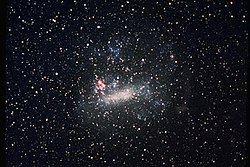Dwarf galaxy

A dwarf galaxy is a small galaxy composed of up to several billion stars. This is a small number compared to our own Milky Way's 200–400 billion stars. The Large Magellanic Cloud, containing over 30 billion stars, is sometimes classified as a dwarf galaxy and sometimes as a full-fledged galaxy orbiting the Milky Way galaxy.
Formation of dwarf galaxies
Most galaxies, including dwarf galaxies, form in association with dark matter or out of gas containing metals. However, NASA's Galaxy Evolution Explorer space probe identified new dwarf galaxies forming out of gases lacking metals. These galaxies were in the Leo Ring, a cloud of hydrogen and helium around two massive galaxies in the constellation Leo.[1]
Dwarf galaxies can be pulled toward and ripped by neighbouring spiral galaxies till they ultimately merge.[2]
Local dwarfs

There are many dwarf galaxies in the Local Group: these small galaxies frequently orbit around larger galaxies, such as the Milky Way, the Andromeda Galaxy and the Triangulum Galaxy. A 2007 paper has suggested that many dwarf galaxies were created by tidal forces during the early evolution of the Milky Way and Andromeda.[4] Tidal dwarf galaxies are produced when galaxies collide and their gravitational masses interact. Streams of galactic material are pulled out away from the parent galaxies and the halos of dark matter that surround them.[1]
The Milky Way has more than 20 known dwarf galaxies orbiting it. Recent observations suggest the largest globular cluster in the Milky Way, Omega Centauri, is actually the core of a dwarf galaxy with a black hole in its center. It was at some time absorbed by the Milky Way.[5]
Dwarf Galaxy Media
The Large Magellanic Cloud, a satellite galaxy of the Milky Way
Dwarf galaxies like NGC 5264 typically possess around a billion stars.
The Phoenix Dwarf Galaxy is a dwarf irregular galaxy, featuring younger stars in its inner regions and older ones at its outskirts.
UGC 11411 is a galaxy known as an irregular blue compact dwarf (BCD) galaxy.
Blue compact dwarf PGC 51017.
A composite color image by the Hubble Space Telescope of the NGC 1052-DF2
LEDA 677373 is located about 14 million light-years away.
References
- ↑ 1.0 1.1 "New recipe for dwarf galaxies: start with leftover gas", Science Daily, 19 February 2009
- ↑ Jaggard, Victoria (9 September 2010). "Pictures: New proof spiral galaxies eat, digest dwarfs". National Geographic Daily News. National Geographic Society. Retrieved 11 February 2012.
- ↑ "Hubble sizes up a dwarf galaxy". Picture of the Week. ESA/Hubble. Retrieved 25 October 2011.
- ↑ Metz, M.; Kroupa (2007). "Dwarf-spheroidal satellites: are they of tidal origin". Monthly Notices of the Royal Astronomical Society. 376 (1): 387–392. arXiv:astro-ph/0701289. Bibcode:2007MNRAS.376..387M. doi:10.1111/j.1365-2966.2007.11438.x. S2CID 16426005.
- ↑ Noyola E; Gebhardt K. and Bergmann M. (2008). "Gemini and Hubble Space Telescope evidence for an intermediate-mass black hole in ω Centauri". The Astrophysical Journal. 676 (2): 1008–1015. arXiv:0801.2782. Bibcode:2008ApJ...676.1008N. doi:10.1086/529002. S2CID 208867075.
{{cite journal}}: CS1 maint: multiple names: authors list (link)








